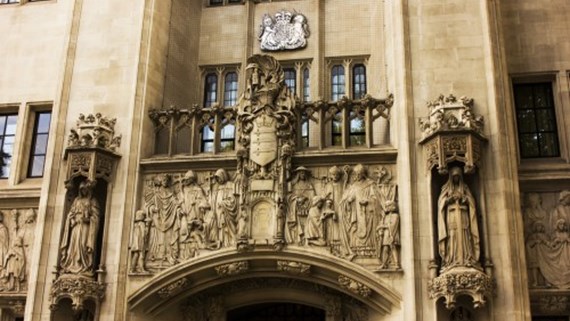The Supreme Court’s judgment in R v Hackney London Borough Council and Agudas Israel Housing Association
Insight

Exemptions for direct discrimination under the Equality Act 2010
The Supreme Court has handed down its judgment in R v Hackney London Borough Council and Agudas Israel Housing Association [1].
The case concerned the lawfulness of a charity’s policy (which reflects its charitable objects) of making social housing available primarily for members of the Orthodox Jewish community (those who practice Judaism in accordance with Orthodox Jewish observance). The surplus of demand for social housing from members of that community, as compared with the number of properties the charity has available, means that in practice because of the charity’s policy, all its properties are allocated to members of the Orthodox Jewish community.
A challenge to this policy was brought on the grounds that it contravened the Equality Act 2010 (the “Act”), in particular the prohibition against “direct discrimination” on the grounds of a protected characteristic [2]. The Supreme Court, upholding the decisions of the Divisional Court and Court of Appeal, concluded that Agudas Israel Housing Association (AIHA) had not acted unlawfully, as it could rely on two exemptions in the Act.
The judgment is of fundamental importance and relevance to charities which focus their activities upon persons who share a protected characteristic. In particular, it clarifies how the courts will approach challenges to the lawfulness of such activities, and how they will apply the exemptions explained below. It also endorses the use of “bright line” criteria by charities, which can help them allocate resources efficiently and consistently, without undue administrative costs.
The claim
In 2017, the applicant (a single mother of four children) was identified by Hackney Council as a priority for new accommodation. But, despite six suitable properties being available in AIHA’s housing stock, Hackney did not put her forward.
The family was not put forward because they were not members of the Orthodox Jewish community, and AIHA in practice (and in line with its governing documents) only made properties available to persons from that community. It was argued that this constituted unlawful direct discrimination as the family were treated less favourably than an Orthodox Jewish family because they did not share the relevant protected characteristic (religion).
Discrimination under the Equality Act
Direct discrimination
AIHA’s allocation policy and practice under that policy was accepted as being an act of direct discrimination under section 13(1) of the Act which states:
“A person (“A”) discriminates against another (“B”) if, because of a protected characteristic, A treats B less favourably than A treats or would treat others.”
Direct discrimination is not unlawful, however, where the actions taken fall within two exemptions in the Act ie those in sections 158 and/or 193.
Section 158
Section 158 (2) provides that the Act does not prohibit a person (such as a charity) from taking any action which is a proportionate means of achieving the aim of:
- alleviating disadvantage experienced by people who share a protected characteristic;
- reducing their under-representation in relation to particular activities; and/or
- meeting their particular needs.
Section 193
Section 193 provides an exemption for charities only. Sub-section (1) provides that a charity which restricts provision of benefit to persons sharing a protected characteristic will not contravene the Act if (a) it is acting in pursuance of its governing documents and (b) the provision of benefits is:
s.193 (2) (a) a proportionate means of achieving a legitimate aim, or
s.193 (2) (b) for the purpose of preventing or compensating for a disadvantage linked to the protected characteristic.
AIHA argued that it could rely on each of these exemptions.
The issues before the Supreme Court
The Supreme Court was required to determine two key issues:
- First, whether the practices of AIHA were a proportionate means of achieving a legitimate aim in accordance with s. 158 (2) and 193 (2) (a). If they were, the appeal would fail.
- Secondly, whether reliance on the limb of the exemption in s. 193 (2) (b) was in fact also subject to a requirement of proportionality (despite that section not referring to proportionality). If it was not, then the appeal would also fail, as AIHA’s actions were plainly for the purpose of preventing or compensating for a disadvantage linked to a protected characteristic.
The Supreme Court was also asked to consider a third issue which was one of more limited application, namely whether AIHA’s policy involved direct discrimination on the grounds of ethnic origin, contrary to EU Directive 2000/43 (the “Race Directive”). The court found that it did not and made a distinction between a charity making decisions about the provision of benefits on grounds of religious observance (not prohibited by the Race Directive), and on grounds of ethnic origin (which is prohibited). AIHA afforded priority (and in practice only offered housing due to demand outstripping supply) to applicants who engaged in Orthodox Jewish religious observance. It was not a requirement that applicants be ethnically Jewish. This subject is discussed further in the postscript to this briefing, which may be of particular interest to our Jewish charity clients.
Issue 1: Proportionality
The Supreme Court ruled that AIHA’s policy was proportionate for the purposes of s. 158 and s. 193 (2) (a).
Referring to the decisions in the lower courts, it noted that the Orthodox Jewish community had high levels of poverty and associated low levels of home ownership. Such disadvantages were exacerbated by rising incidents of anti-Semitism and the fact that Orthodox Jews often faced prejudice in the private rental sector. These disadvantages were connected to their protected characteristic (religion).
The Orthodox Jewish community also had specific needs, which were different to those people who did not share their protected characteristic. These included needing (i) to live relatively close to each other and (ii) larger than average housing (to accommodate larger than average families).
The Supreme Court agreed that AIHA’s allocation policy was a legitimate and proportionate means of both meeting the needs of the Orthodox Jewish community and seeking to correct the disadvantages suffered by them. The court was entitled to weigh the benefits of AIHA’s policy to the Orthodox Jewish community as a group, against the disadvantages experienced by other groups as a result of the policy. It was pertinent that the properties provided by AIHA constituted only around 1 per cent of total housing stock in Hackney. The impact of AIHA’s policy on other groups was, therefore, extremely small.
In addition, the Supreme Court noted that AIHA policy stipulated that if there was a surplus of housing beyond the Orthodox Jewish community, these properties would be allocated to those outside the community. The court noted that even though the current market circumstances (with high demand from the community) acted to give “a blanket effect” to the policy, AIHA was not acting disproportionately. In fact, it was suggested that even a blanket policy would be proportionate until the point that the disadvantages that AIHA’s policy sought to address had been eliminated.
Issue 2: is proportionality a requirement of the exemption under S. 193(2)(b)?
The Supreme Court also held that the exemption under s. 193 (2) (b) was not subject to a proportionality analysis. First, it was not possible to read such a requirement into the wording of that section without making it redundant (as it would simply mimic the separate exemption at s. 193 (2) (a) (which is subject to a proportionality requirement)).
Secondly, the court noted that while proportionality was a general requirement of EU anti-discrimination legislation, Parliament had plainly intended s. 193 (2) (a) and 193 (2) (b) to serve as distinct conditions for the operation of the charitable exemption, and had considered that satisfaction of either of those exemptions would constitute justification for discrimination which would meet the requirements of EU law (for example under the Race Directive). Therefore, having regard to:
- the fact that charitable provision supplements basic social welfare provision by the state;
- the general regulation of charities to ensure they provide public benefit;
- the desirability of ensuring that the resources of charities are not diverted from being used to meet social needs and towards dealing with challenges to their decisions; and
- the way in which Parliament had carefully and deliberately framed the section 193(2)(b) limb of the exemption to meet the proportionality tests in EU law, and under the European Convention on Human Rights, there was no basis to imply an additional proportionality requirement which a charity would be required to demonstrate in every or any case falling before it.
The role of charities
A recognition of the importance of charities and the interplay between their role and the drafting of the exemption in section 193 (2) (b) was also examined.
In this regard, the Supreme Court noted that to qualify as a charity, an organisation had to be established for a charitable purpose, and that a charitable purpose was one which fell within certain categories and was for the public benefit. The public benefit requirement will not be satisfied if a charity’s activities have unduly detrimental wider effects in society [3].
In addition, the court held that it was not in the public interest that charities’ scarce resources be spent on administrative costs resulting from their carrying out a full analysis of the competing needs and disadvantages of particular applicants for benefit. Charities, like the state, were therefore entitled to use “bright line” criteria for the distribution of benefit (ie to focus provision of social welfare benefits on a particular group, and hence exclude other groups, even though there may be little or no difference at the margins in terms of need between some particular individual in the first group and another particular individual in the excluded groups). Employing such criteria would ensure that the maximum resources were available to address the problems that charities sought to alleviate. This practice would inevitably exclude some from benefit, despite there being marginal differences in terms of need between the person excluded, and the person benefitting. But it would also minimise administrative costs, reduce delay in the provision of benefits, and provide for clear rules that can be applied consistently.
Conclusion
The Supreme Court decision provides some clarification for charities whose charitable purposes favour a class with a protected characteristic about the extent to which they may focus their efforts on that group, without those efforts being found to be unlawful under the Act. It also confirms that such charities may utilise “bright line” criteria in their decision-making process, and that policies which have a "blanket effect" may still be proportionate.
Perhaps most importantly, the judgment confirms that under s. 193 (2) (b) such a charity, where acting in pursuance of provision in its governing documents (which will usually be in the clause setting out its charitable objects or purposes), provides benefits to persons sharing a particular “protected characteristic” to the exclusion of those who do not, will not have acted unlawfully so long as the actions of that charity are for the purposes of preventing or compensating for a disadvantage linked to a protected characteristic. No separate proportionality analysis is required.
There are many charities which were established to benefit people with a protected characteristic but whose governing documents do not reflect that fact. Although not specifically addressed in the judgment, most advisers and the Charity Commission take the view that such charities cannot invoke the exemption in section 193 of the Act and must rely on other provisions of the Act if they wish to limit charitable benefits or services in a potentially discriminatory manner.
Reading this briefing, some charities may be asking themselves whether they could or should change their governing documents. This subject is addressed in the Charity Commission’s guidance on the Act [4]. Equalities law is complex and we recommend that any charity worried about whether they are currently operating lawfully, or wanting to consider a change to their governing documents seek expert professional advice.
Postscript – The Race Directive and the JFS case
The Race Directive
The Race Directive prohibits direct or indirect discrimination based on racial or ethnic origin within EU member states. Article 5 of the Race Directive however provides for a limited exception to the prohibition, namely through “positive action” to prevent or compensate for disadvantages linked to a person’s racial or ethnic group. Examples of these exceptions are sections 158 and 193 of the Act. However, as such positive action represents a derogation from EU law principles of non-discrimination and equal treatment, it was argued that any such positive action was to be construed in accordance with the principle of proportionality.
At the Supreme Court, the appellant (for the first time) therefore argued that AIHA’s policy in fact constituted unlawful discrimination on the grounds of race, and not only religion. In support of its case, the appellant argued that the practical effect of AIHA’s policy of affording housing to members of the Orthodox Jewish community, in priority to people who were not part of that community, was that it was discriminating on the grounds of race. This was because, the appellant said, membership of the Orthodox Jewish community was a criterion of ethnic origin, and not solely a religious criterion, and cited the landmark Jewish Free Schools case (JFS) in support.
The JFS case
The JFS case [5] concerned a complaint that the admissions criteria adopted by the Jewish Free School involved unlawful direct discrimination on the grounds of ethnic origin, contrary to the Race Relations Act 1976. This was because only those children who were recognised as Jewish according to the Office of the Chief Rabbi could be admitted, such recognition being based on matrilineal descent from a Jewish mother or one who had been converted in accordance with the tenets of Orthodox Judaism.
Based on this policy, a child had been refused admission to the school. This was because their mother had converted to non-Orthodox Judaism, which was not recognised by the Office of the Chief Rabbi.
In JFS, the Supreme Court held that the test of matrilineal descent applied by the school was a test of ethnic origin, and that therefore the school’s policy involved direct discrimination on the grounds of race.
This remains good law and is not affected by the AIHA case.
The Supreme Court’s application of the judgment in JFS
The Supreme Court rejected the appellant’s argument based on JFS.
The court held that AIHA did not make its selection on the grounds of a person’s matrilineal descent, but on whether they engaged in Orthodox Jewish religious observance. Discrimination on the grounds of religion was not prohibited by the Race Directive. And, in fact, in JFS there was no requirement that an applicant for a place at the school practice the Jewish faith. The children in question simply had to be recognised as Jewish in the eyes of the Office of Chief Rabbi (and would be so recognised even if they in fact practiced some other religion).
The court further noted that no evidence had been put forward regarding whether persons who engage in Orthodox Jewish observance might, by virtue of that, fall to be regarded as part of some wider Jewish ethnic group, differently constituted to those who might be identified under the ruling in JFS. The court held that it was possible that they might, but that the question was not straightforward.
A question for the future
In light of the lack of evidence before it (a result of the claim based on the Race Directive being raised very late indeed, and only after the decisions of the lower courts), the Supreme Court was not able to make any definitive finding as to whether observance of Orthodox Jewish religious practices might render a person part of the Jewish ethnic group.
The court noted that the question was “not a straightforward one”, and would require an analysis of a range of legal issues, including whether the concept of ethnic origin in the Race Directive was the same as in the Race Relations Act 1976 (which was the relevant statutory provision considered in JFS) and now in the Act, whether a defence existed under Article 5 of the Race Directive, whether the Race Directive can have a “horizontal effect” in relation to a private body like AIHA, whether it were possible to read provisions of the Act compatibly with the Race Directive, and whether article 21 of the Charter of Fundamental Rights of the European Union was engaged. It would also require evidence, including the extent to which such persons might be accepted by other Jews as part of their ethnic group, or might be perceived as such by non-Jews.
Summary
As we’ve mentioned, the Supreme Court decision will provide some clarification for charities that focus their efforts upon improving the lives of groups of people defined by protected characteristics. In particular, it confirms how the exemptions referred to above will be considered by the court, and that s. 193 (2) (b) is not subject to a requirement of proportionality.
Importantly for Jewish charities, it indicates that charities which focus their efforts on those who practice Judaism in a particular way, will be able to rely on the exemptions set out in the Act, and will not have unlawfully discriminated in any way.
The question therefore which remains is this – to what extent does religious observance cause a person to be seen in law as a member of a specific ethnic group? Unfortunately, this was not ruled upon by the Supreme Court, and so that question must be left to be determined. However, it appears in our view unlikely that religious observance alone will cause a person to fall within one particular group. As the Supreme Court noted, the test for determining whether a person falls within a particular ethnic group was laid down in Mandla v Dowell Lee [6], where the House of Lords identified seven characteristics that were relevant.
One of those included a cultural tradition, including family and social customs and manners, which were often, but not necessarily, associated with religious observance.
If you require further information about anything covered in this briefing, please contact Joanna Poole, or your usual contact at the firm on +44 (0)20 3375 7000.
This publication is a general summary of the law. It should not replace legal advice tailored to your specific circumstances.
© Farrer & Co LLP, October 2020
Footnotes:
[1] [2020] UKSC 40
[2] The “protected characteristics” under the Act include age, disability, race, religion, sex, and sexual orientation
[3] Which was not the case prior to the Equality Act 2010. See also R (Independent Schools Council) v Charity Commission for England and Wales [2011] UKUT 421 (TCC)
[5] R (on the application of E) v Governing Body of JFS and the Admissions Appeal Panel of JFS and others; R (on the application of E) v Governing Body of JFS and the Admissions Appeal Panel of JFS and others (United Synagogue intervening) [2009] UKSC 15.
[6] Mandla (Sewa Singh) v Dowell Lee [1983] 2 AC 548




